
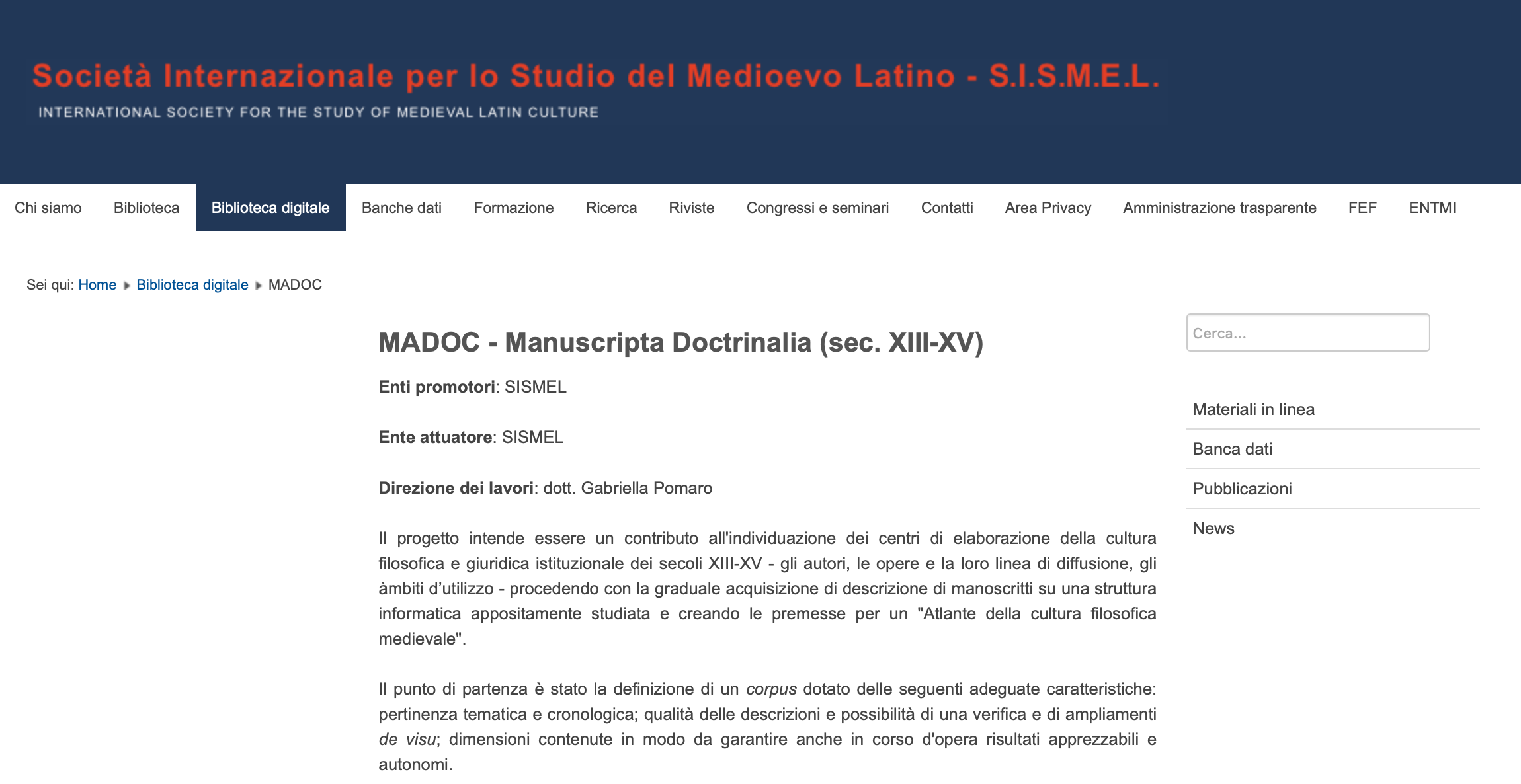 MADOC – Manuscripta Doctrinalia (sec. XIII-XV) – SISMEL The project intends to be a contribution to the identification of the centers of development of the institutional philosophical and legal culture of the 13th-15th centuries – the authors, the works and their line of diffusion, the areas of use – proceeding with the gradual acquisition of manuscript descriptions on a specifically designed computer structure and creating the premises for an “Atlas of medieval philosophical culture”. The starting point was the definition of a corpus with the following adequate characteristics: thematic and chronological relevance; quality of the descriptions and possibility of verification and expansion de visu; small dimensions so as to guarantee appreciable and autonomous results even during the work.
MADOC – Manuscripta Doctrinalia (sec. XIII-XV) – SISMEL The project intends to be a contribution to the identification of the centers of development of the institutional philosophical and legal culture of the 13th-15th centuries – the authors, the works and their line of diffusion, the areas of use – proceeding with the gradual acquisition of manuscript descriptions on a specifically designed computer structure and creating the premises for an “Atlas of medieval philosophical culture”. The starting point was the definition of a corpus with the following adequate characteristics: thematic and chronological relevance; quality of the descriptions and possibility of verification and expansion de visu; small dimensions so as to guarantee appreciable and autonomous results even during the work.
To consult the website MADOC – Manuscripta Doctrinalia (sec. XIII-XV) – SISMEL click here
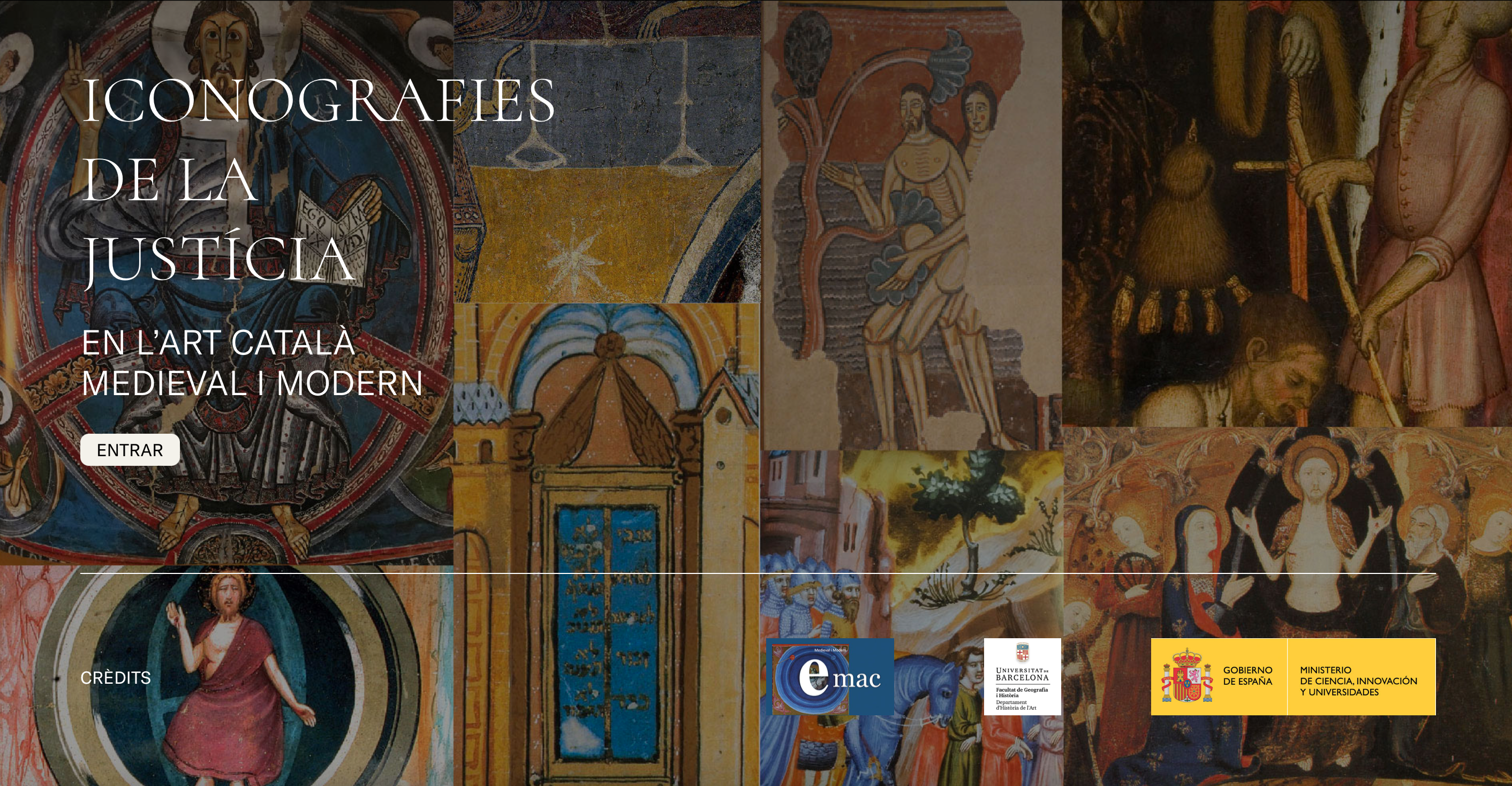
Website ICONOGRAFIES DE LA JUSTÍCIA. EN L’ART CATALÀ MEDIEVAL I MODERN The contents of this Website are based on the research carried out by the EMAC Group of the University of Barcelona, partner of our research team, on Justice and Judgment in Catalan art of the Middle Ages and the modern era, directed by Rosa Alcoy, member of the scientific committee of our research team.
To consult the website ICONOGRAFIES DE LA JUSTÍCIA. EN L’ART CATALÀ MEDIEVAL I MODERN click here
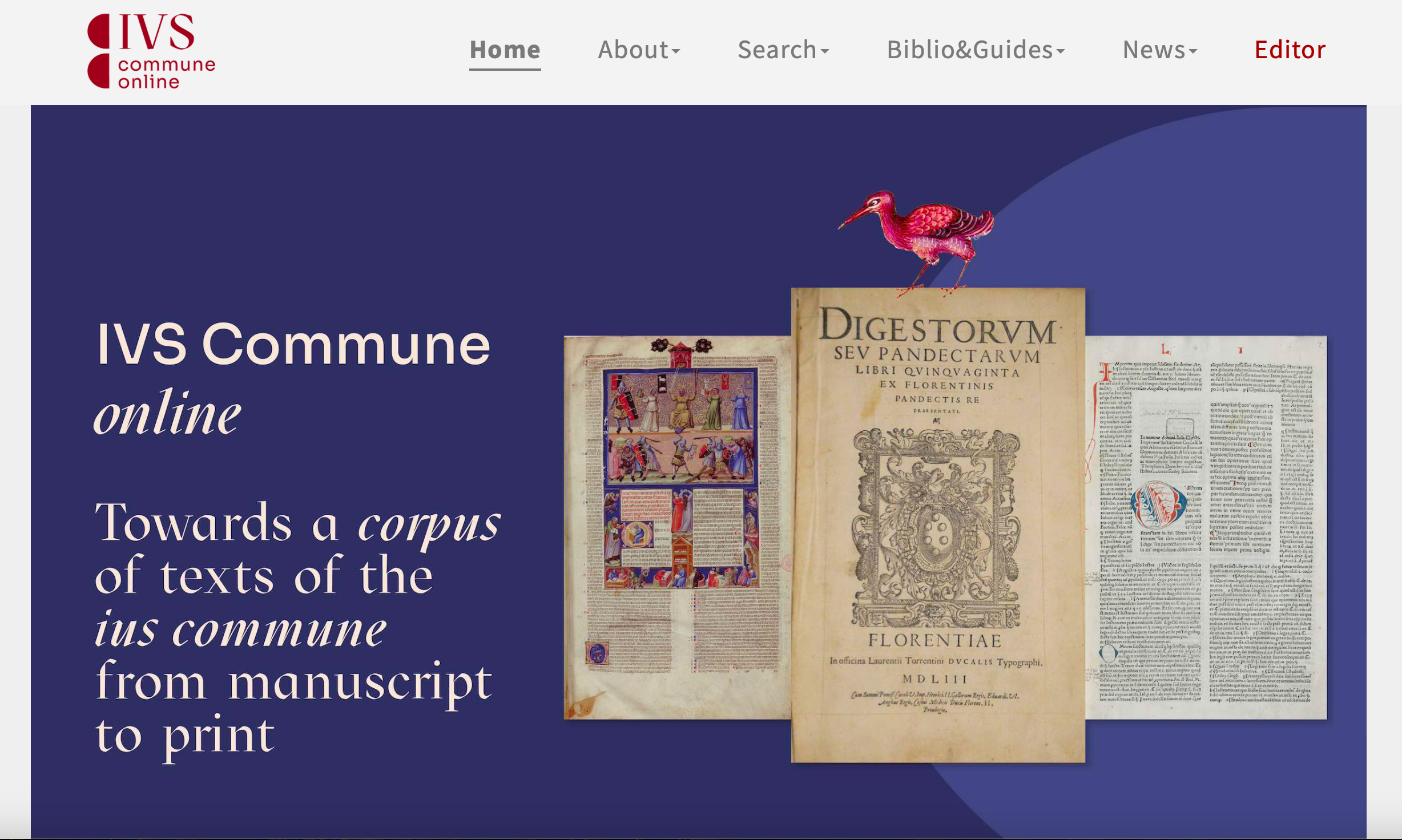 IVS Commune online (ICo) is a digital tool meant to host analytical descriptions of legal texts transmitted in either manuscripts or printed editions and published from medieval to early modern age. The main purpose is allowing for a comparative study of the transmission of texts over the centuries, but also to facilitate the study of the evolution of the book as a material object. The ICo database did not start from the ground; it was inspired by the work done on the texts printed in the incunabula editions and described in the TEXT-inc database (http://textinc.bodleian.ox.ac.uk). ICo was actually conceived as an expansion of TEXT-inc, from which it took the core design and all relevant data: about 250 records related to editions of legal texts plus the indexes of authors (an agreement between Cristina Dondi and Alessandra Panzanelli was signed for the purpose). On this basis, some work was done to create a new tool capable of hosting texts from later editions and manuscripts, plus several other features. The very structure has been fully revised (the db management system has been changed, from PostgreSQL to MySQL; more details can be found in the technical descriptions provided by Luigi Tessarolo who developed the new database). At the core of the database there are two sections: one dedicated to the analytical description of the texts (Content Analysis) and another section dedicated to the analysis of the book in its materiality (Bibliographical analysis). All data, however, are recorded to provide information on the transmission of the text. Indeed, data pertaining the construction of the book (e.g.: material support, sheet size, collation, writing system, typeface, illustrations, even the layout as a whole) are recorded to be analysed as evidence of the evolution of the texts. Indeed, the editor is given the opportunity to start the data analysis already in the moment of its recording, e.g. by linking editions on the basis of analogies found also in material aspects. As for texts, ICo aims to facilitate the identification of the work (through a uniform title) and related apparatus of paratextual material. The link between main record and indexes has been enhanced as well as the semantic analysis and the interoperability by adding a direct link towards several digital tools which are considered most relevant. From book privileges to illustrations, from MANUS online to HPB, ICo aims to present itself as part of a network of tools which all contribute to the study of the written cultural heritage. Most important, work was done on the display of the search results, which aims to allow a comparative study of the texts.
IVS Commune online (ICo) is a digital tool meant to host analytical descriptions of legal texts transmitted in either manuscripts or printed editions and published from medieval to early modern age. The main purpose is allowing for a comparative study of the transmission of texts over the centuries, but also to facilitate the study of the evolution of the book as a material object. The ICo database did not start from the ground; it was inspired by the work done on the texts printed in the incunabula editions and described in the TEXT-inc database (http://textinc.bodleian.ox.ac.uk). ICo was actually conceived as an expansion of TEXT-inc, from which it took the core design and all relevant data: about 250 records related to editions of legal texts plus the indexes of authors (an agreement between Cristina Dondi and Alessandra Panzanelli was signed for the purpose). On this basis, some work was done to create a new tool capable of hosting texts from later editions and manuscripts, plus several other features. The very structure has been fully revised (the db management system has been changed, from PostgreSQL to MySQL; more details can be found in the technical descriptions provided by Luigi Tessarolo who developed the new database). At the core of the database there are two sections: one dedicated to the analytical description of the texts (Content Analysis) and another section dedicated to the analysis of the book in its materiality (Bibliographical analysis). All data, however, are recorded to provide information on the transmission of the text. Indeed, data pertaining the construction of the book (e.g.: material support, sheet size, collation, writing system, typeface, illustrations, even the layout as a whole) are recorded to be analysed as evidence of the evolution of the texts. Indeed, the editor is given the opportunity to start the data analysis already in the moment of its recording, e.g. by linking editions on the basis of analogies found also in material aspects. As for texts, ICo aims to facilitate the identification of the work (through a uniform title) and related apparatus of paratextual material. The link between main record and indexes has been enhanced as well as the semantic analysis and the interoperability by adding a direct link towards several digital tools which are considered most relevant. From book privileges to illustrations, from MANUS online to HPB, ICo aims to present itself as part of a network of tools which all contribute to the study of the written cultural heritage. Most important, work was done on the display of the search results, which aims to allow a comparative study of the texts.
ICo was created to realise one of the main goals of the Project “The sources of the law in Europe in late medieval and early modern times. Towards a corpus of Texts of the Ius Commune from manuscript to print (1350-1650)” funded by the Ministry of University and Research within the Programma Giovani Ricercatori “Rita Levi Montalcini” (Call 2017) and led by Alessandra Panzanelli in the Department of Historical Studies of the University of Turin (2019-22). Since December 2022 ICo is being developed and enhanced by the research activities conducted within the framework of Spoke 3 (Digital Libraries, Archives and Philology) of the Extended Partnership CHANGES – Cultural Heritage Active Innovation for Nex-Gen Sustainable Society Extended Partnership (Progetto PE 0000020 CHANGES, – CUP D53C22002530006, PNRR Missione 4 Componente 2 Investimento 1.3, finanziato dall’Unione europea – NextGenerationEU”). ICo is freely available on the web; editing data are also free for all who work on the transmission of legal texts and who would like to use ICo as a tool for analysis. Those who like to join the project, please get in touch (write to the General editor: mariaalessandra.panzanellifratoni@unito.it).
To consult the website of the IVS Commune online (ICo) project click here
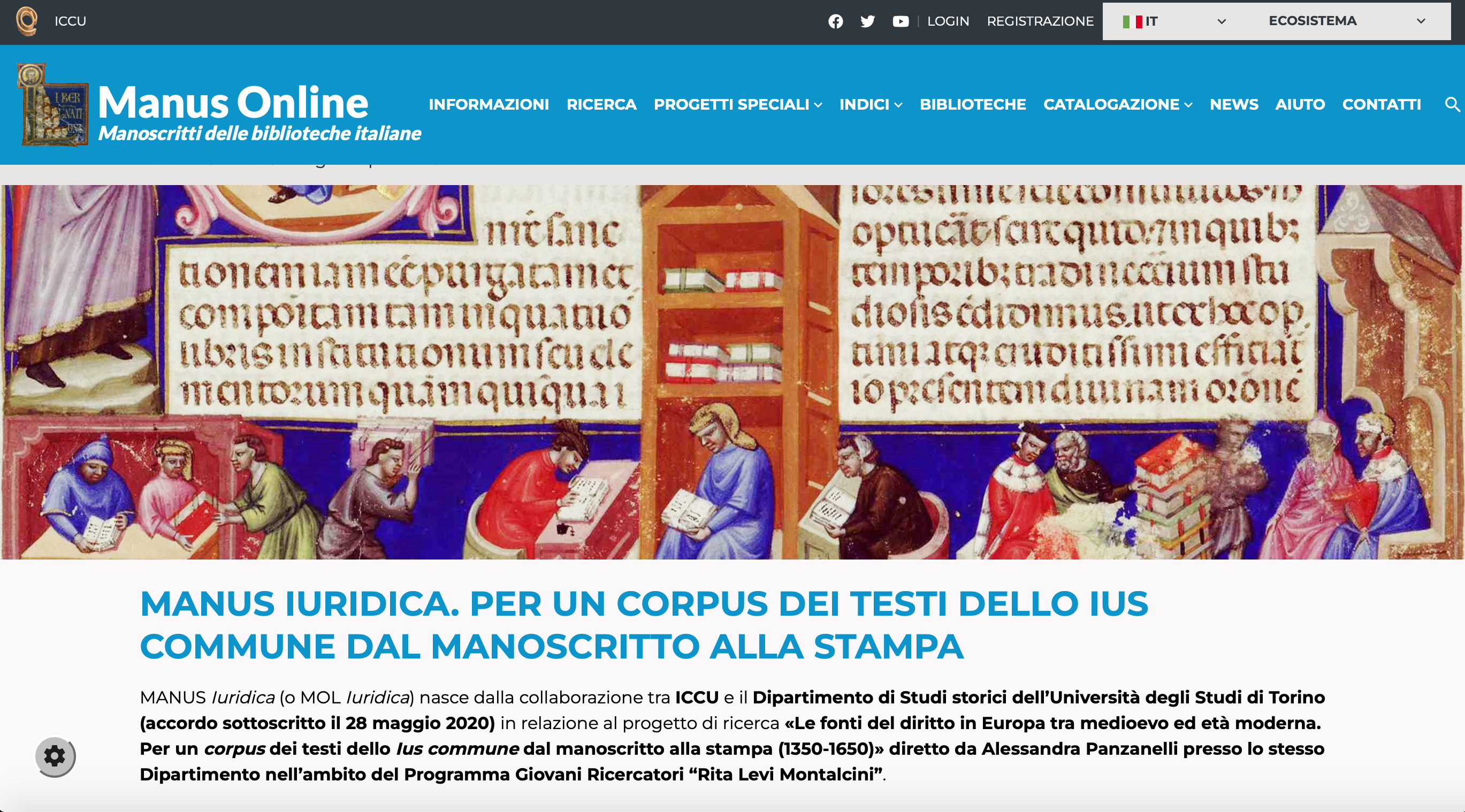 MANUS IURIDICA. PER UN CORPUS DEI TESTI DELLO IUS COMMUNE DAL MANOSCRITTO ALLA STAMPA. MANUS Iuridica (or MOL Iuridica) was born from the collaboration between ICCU and the Department of Historical Studies of the University of Turin (agreement signed on 28 May 2020) in relation to the research project «The sources of law in Europe between the Middle Ages and the modern age. For a corpus of the texts of the Ius commune from manuscript to printing (1350-1650)» directed by Alessandra Panzanelli at the same Department as part of the Young Researchers Program “Rita Levi Montalcini”. The special project MANUS Iuridica aims to achieve some long-awaited objectives, such as the great undertaking of the Codices Operum Bartoli a Saxoferrato reviewed, started in the 1960s by Emanuele Casamassima (under the direction of Bruno Paradisi) and from which the catalogues of the manuscripts of Bartolo da Sassoferrato were born (the most famous jurist of the late Middle Ages, thousands of copies of whose works are preserved in libraries in all Western countries). The special project aims to collect in one place the analytical descriptions of the legal manuscripts preserved in Italy and outside of Italy, also valorizing the large amount of material that already exists but resides in separate places: paper publications or online catalogues and censuses, starting from the pioneering works of Gero Dolezalek (such as the Verzeichnis der Handschriften zum römischen Recht bis 1600. Frankfurt a.M.: MPI, 1974, now available through the Manuscripta juridica database: http://manuscripts.rg.mpg.de/). MANUS Iuridica is open to the participation of all scholars who wish to join and, obviously, of the curators of the libraries that preserve the manuscripts, whether they are already in MANUS (in which case individual agreements will be made on the management of the cards and the sharing of the data) or not yet present. A scientific collaboration has already been established with Maria Alessandra Bilotta, head of the project «IUS Illuminatum» (University of Lisbon: https://iusilluminata.fcsh.unl.pt/) dedicated to miniatures in legal manuscripts, in collaboration with which the methods of analysis and description of the aspects of iconography and decoration are being developed. MANUS Iuridica intends to avail itself of the expertise of specialists in the field, such as codicologists, paleographers, legal historians, university historians.
MANUS IURIDICA. PER UN CORPUS DEI TESTI DELLO IUS COMMUNE DAL MANOSCRITTO ALLA STAMPA. MANUS Iuridica (or MOL Iuridica) was born from the collaboration between ICCU and the Department of Historical Studies of the University of Turin (agreement signed on 28 May 2020) in relation to the research project «The sources of law in Europe between the Middle Ages and the modern age. For a corpus of the texts of the Ius commune from manuscript to printing (1350-1650)» directed by Alessandra Panzanelli at the same Department as part of the Young Researchers Program “Rita Levi Montalcini”. The special project MANUS Iuridica aims to achieve some long-awaited objectives, such as the great undertaking of the Codices Operum Bartoli a Saxoferrato reviewed, started in the 1960s by Emanuele Casamassima (under the direction of Bruno Paradisi) and from which the catalogues of the manuscripts of Bartolo da Sassoferrato were born (the most famous jurist of the late Middle Ages, thousands of copies of whose works are preserved in libraries in all Western countries). The special project aims to collect in one place the analytical descriptions of the legal manuscripts preserved in Italy and outside of Italy, also valorizing the large amount of material that already exists but resides in separate places: paper publications or online catalogues and censuses, starting from the pioneering works of Gero Dolezalek (such as the Verzeichnis der Handschriften zum römischen Recht bis 1600. Frankfurt a.M.: MPI, 1974, now available through the Manuscripta juridica database: http://manuscripts.rg.mpg.de/). MANUS Iuridica is open to the participation of all scholars who wish to join and, obviously, of the curators of the libraries that preserve the manuscripts, whether they are already in MANUS (in which case individual agreements will be made on the management of the cards and the sharing of the data) or not yet present. A scientific collaboration has already been established with Maria Alessandra Bilotta, head of the project «IUS Illuminatum» (University of Lisbon: https://iusilluminata.fcsh.unl.pt/) dedicated to miniatures in legal manuscripts, in collaboration with which the methods of analysis and description of the aspects of iconography and decoration are being developed. MANUS Iuridica intends to avail itself of the expertise of specialists in the field, such as codicologists, paleographers, legal historians, university historians.
To consult the website of the MANUS Iuridica (or MOL Iuridica) project click here
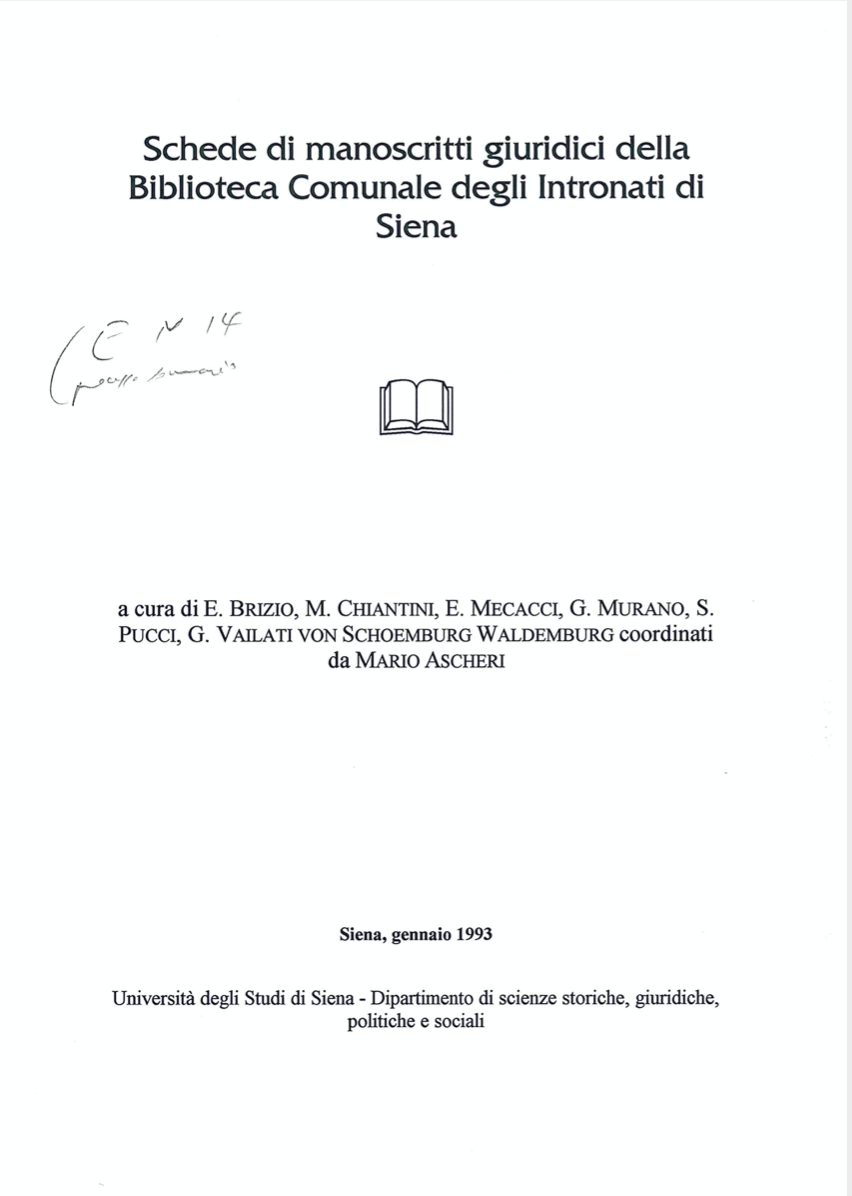 Schede di manoscritti giuridici della Biblioteca Comunale degli Intronati di Siena, a cura di E. Brizio, M. Chiantini, E. Mecacci, G. Murano, S. Pucci, G. Vailati von Schoenburg Waldenburg, coordinati da Mario Ascheri, Siena, gennaio 1993
Schede di manoscritti giuridici della Biblioteca Comunale degli Intronati di Siena, a cura di E. Brizio, M. Chiantini, E. Mecacci, G. Murano, S. Pucci, G. Vailati von Schoenburg Waldenburg, coordinati da Mario Ascheri, Siena, gennaio 1993
To consult the pdf of the catalog, click on the image of the cover
 The IRNERIO project
The IRNERIO project
“The core part of this project consists in digitizing and classifying the vast collection of legal and theologico-philosophical codices making up the rare-books collection of the Reale Collegio di Spagna in Bologna: with this digital catalogue, built under the guidance of Professors Domenico Maffei and Andrea Padovani, not only can the fragile codices be readily accessed and studied, but their preservation for future use is guaranteed, too. The project -named for the primus illuminator of Bolognan legal science, the Italian jurist Irnerius – would not have been possible had the Collegio di Spagna not made its rare-books collection available. Funding for the project comes from the Fondazione Cassa di Risparmio in Bologna, and also from the Italian Ministry of Higher Education and Scientific Research. The digital images have been reproduced under the editorship of the publishing house CLUEB.”
To consult the website of the Irnerio Project and the digital catalog of the manuscripts of the Library of the College of Spain in Bologna click here
 Manuscripta juridica
Manuscripta juridica
[Principal Investigator: G. R. Dolezalek]
Manuscripta Juridica is by far the oldest electronic collection of data about manuscripts. It was established in 1972 on a main frame computer of the Max-Planck-Society, for its Institute of European Legal Historz, long before personal desk computers and laptop computers were invented. In its origin, the collection bore the name “Verzeichnis der Handschriften zum römischen Recht bis 1600”. In 2012 the Max-Planck-Institute for European Legal History finally uploaded this data collection on the internet – in a meanwhile widely enlarged and restructured version. At present, “Manuscripta Juridica” contains data of more than 33.000 items of handwritten legal literature, preserved in more than 11.000 manuscripts, which are held in more than 1000 locations. The data base mainly exploits legal-historical literature. It registers information gathered by legal historians about contents of manuscripts which comprise juridical items. In Manuscripta Juridica, illustrations are usually passed over without mentioning: namely illustrations lay outside the scope of this data base. Nevertheless, in cases where “Manuscripta Juridica” furnishes particularly detailed descriptions of manuscripts, also some illustrations may be mentioned – however just shortly, en passant. For the scope of this international congress, the undersigned intends to upload onto the internet a list of those items in Manuscripta Juridica which actually do mention illustrations.
To consult the website of Manuscripta juridica and the digital catalog of the legal manuscripts click here
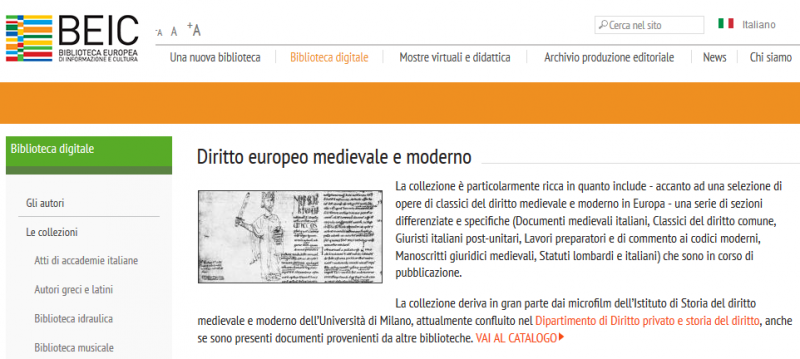 The collection of legal texts digitized by the European Library of Information and Culture Foundation (BEIC)
The collection of legal texts digitized by the European Library of Information and Culture Foundation (BEIC)
The collection is divided into several sections:
Classics of Common Law (12th-18th centuries): 874 works published so far, including 279 incunabula
Medieval legal manuscripts: 1,712 manuscripts from 198 libraries available so far. The activity will continue until the digitization of the entire collection which includes over 3,500 manuscripts and which represents the most complete collection existing in Europe of microfilms of medieval and early modern legal manuscripts (Germanic laws, Roman law, canon law, laws and doctrines of common law from the glossators to the cultural school and beyond)
Italian statutes: 306 statutes available so far that will reach over 3,000 by 2018, which make up the collection of the Institute of the History of Medieval and Modern Law of the University of Milan.
To consult the digital catalog of Medieval legal manuscripts click here
 For.Ma. The Forgotten Manuscripts – I manoscritti dimenticati della Biblioteca Universitaria di Padova (nn. 688 e 941)
For.Ma. The Forgotten Manuscripts – I manoscritti dimenticati della Biblioteca Universitaria di Padova (nn. 688 e 941)
‘Form.Ma – The Forgotten Manuscripts ‘is a research project initiated by the Department of Private Law and Critique of Law of the University of Padua thanks to the financial support of the Cassa di Risparmio di Padova and Rovigo Foundation, which awarded it among the’ Projects of Excellence 2017 ‘. The project aimed to study and enhance two precious and almost forgotten manuscripts of the 12th century preserved in the University Library of Padua, which contain some parts of the Corpus Iuris Civilis, the monumental collection of Roman legal texts created by Justinian in the 6th century AD.
To consult the digitized version of two precious manuscripts dating back to the 12th century, kept at the University Library of Padua and containing some parts of the ‘Corpus Iuris Civilis’ (The manuscripts 688 and 941 of the University Library of Padua) click here
![]() Le Miroir des classiques – Repertory of translations of Latin and Greek classics made in French and Occitan during the Middle Ages [Principal Investigator: F. Duval]
Le Miroir des classiques – Repertory of translations of Latin and Greek classics made in French and Occitan during the Middle Ages [Principal Investigator: F. Duval]
“The Mirror of the Classics is a repertory of translations of Latin and Greek classics made in French and Occitan during the Middle Ages. Under the title of each translated work, the various translations are presented in their chronological order as well as their possible changes. For each translation, characterized quickly, is provided a precise analysis of the manuscripts and editions (incunabula and editions of the sixteenth century) that keep it. The Gallo-Roman translations of Corpus Juris civilis, largely unknown, have been the subject of particularly detailed treatment and constitute a largely autonomous sub-corpus“
Duval (Frédéric), Miroir des classiques, Paris : École nationale des chartes, 2007-… Édition électronique : http://elec.enc-sorbonne.fr/ (consulté le 6.10.2021)
To consult the digitized of Gallo-Roman translations of Corpus Juris civilis click here
 The Medieval Canon Law Virtual Library – Website.
The Medieval Canon Law Virtual Library – Website.
This site is curated by David M. Freidenreich, Colby College; many of the scans found on this site were prepared by Edward Reno III, Columbia University.
The purpose of this site is to bring together in a single virtual location publicly accessible electronic resources for the study of medieval canon law. It’s a work in progress
To consult the Website click here
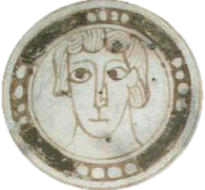 The Carolingian Canon Law Project
The Carolingian Canon Law Project
To consult the Website of the project click here
 Continuation of the series of volumes published by Stephan Kuttner and Reinhard Elze in 1986 and 1987.
Continuation of the series of volumes published by Stephan Kuttner and Reinhard Elze in 1986 and 1987.
(Provisional publication by Gero R. Dolezalek in collaboration with Martin Bertram)
To consult the Website click here

“The present “Canon Law Incipit List” is the fruit of a co-operative research project: the University of Leipzig (Prof. G. Dolezalek) wrote respective computer programs, and Dr. Giovanna Murano collected and delivered all the input data.”
To consult the Website and download the list click here
 Edited by Prof. G. Dolezalek, contains: (1) Data Base ‘Manuscripta Juridica’, Max-Planck-Institut für europäische Rechtsgeschichte (cfr. supra); (2) Some data collected by Dolezalek to update ‘Manuscripta Juridica‘ (mainly telling who published what, where, when, on which manuscripts); (3) Catalogue of Canon and Roman Law Manuscripts in the Vatican Library, volume III resuscitated (Provisional publication by Gero R. Dolezalek in collaboration with Martin Bertram) (cfr. supra); (4) Inventory of manuscripts from the library of the former “Reichsgericht”, now again at Leipzig, Library of the Bundesverwaltungsgericht; (5) Dr. Giovanna Murano‘s list of canon law incipits (cfr. supra); (6) ‘Manuscripta Mediaevalia‘ – the main data base of catalogues of manuscripts; (7) Samples of other links: Legal historical literature in manuscript (update 2010_11_13)
Edited by Prof. G. Dolezalek, contains: (1) Data Base ‘Manuscripta Juridica’, Max-Planck-Institut für europäische Rechtsgeschichte (cfr. supra); (2) Some data collected by Dolezalek to update ‘Manuscripta Juridica‘ (mainly telling who published what, where, when, on which manuscripts); (3) Catalogue of Canon and Roman Law Manuscripts in the Vatican Library, volume III resuscitated (Provisional publication by Gero R. Dolezalek in collaboration with Martin Bertram) (cfr. supra); (4) Inventory of manuscripts from the library of the former “Reichsgericht”, now again at Leipzig, Library of the Bundesverwaltungsgericht; (5) Dr. Giovanna Murano‘s list of canon law incipits (cfr. supra); (6) ‘Manuscripta Mediaevalia‘ – the main data base of catalogues of manuscripts; (7) Samples of other links: Legal historical literature in manuscript (update 2010_11_13)
To consult the Website and download the list click here
